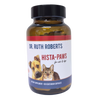Seizures, also known as fits or convulsions, are a concerning experience for both pets and their owners. While they can occur in animals of any age, they become more frequent in older pets. Understanding the causes, symptoms, and management of seizures is crucial for pet parents to provide timely care and support for their senior companions.
Why Do Dogs and Cats Have Seizures?
Understanding the underlying reasons for these seizures is crucial for managing your pet's health and ensuring their well-being as they age. Below, we explore the key factors contributing to seizures in older dogs and cats, shedding light on how age-related changes in their bodies can lead to this alarming condition.
- Aging Process: As pets age, their bodies become more susceptible to health issues that can lead to seizures.
- Organ Dysfunction:
- Pancreas: Less efficient regulation of blood sugar levels can cause fluctuations, potentially leading to seizures.
- Liver: Impaired liver function affects metabolism and blood sugar regulation, disrupting brain function.
- Kidneys: Inefficient kidney function can disrupt electrolyte balance, affecting nerve function.
- Blood Sugar Fluctuations: Both hypoglycemia (too low) and hyperglycemia (too high) can disrupt normal brain function, leading to seizures.
- Electrolyte Imbalance: Caused by kidney dysfunction, affecting nerve function and potentially leading to seizures.
- Metabolic Issues: As metabolism slows or becomes less efficient, the risk of seizures can increase due to the inability to properly process toxins or regulate necessary body functions.
In older dogs, seizure can come from various health issues. Strokes cause brain damage, leading to seizures. Brain tumors disrupt brain function. Neurological conditions like epilepsy increase seizure risk. Cerebrovascular disease affects brain blood vessels. Dementia, linked to brain changes, also leads to seizures. Central nervous system infections cause brain inflammation. Traumatic injuries can damage the brain. Autoimmune disorders attack brain tissues. Metabolic imbalances disrupt brain function. Treating these causes is crucial for managing seizures.
Symptoms of Seizures in Pets
Seizures in pets result from sudden, excessive electrical activity in the brain, manifesting through various symptoms. Identifying these can help differentiate seizures from other conditions, ensuring prompt and appropriate care.
Common symptoms include:
- Sudden Collapse: Pets may appear weak or disoriented rather than fully collapsing.
- Muscle Twitching/Stiffness: May affect the entire body or one side, often less intense in older pets.
- Loss of Consciousness: Pets might seem completely unaware or just confused; older animals may appear lethargic or disoriented afterward.
- Involuntary Elimination: Less common but possible loss of bladder or bowel control.
- Paddling Motions: Slower or less coordinated leg movements in generalized seizures.
- Drooling: Excessive salivation during seizures.
- Vocalization: Sounds like whining or crying may occur.
Not all unusual behaviors indicate a seizure. Tremors, dizziness, fainting, and natural sleep movements can be confused with seizures but have distinct characteristics. Recognizing these symptoms helps in providing the right response to your pet's health needs.
What to Do if Your Pet Have Seizure
If your dog or cat has a seizure, immediate veterinary assistance is crucial. Here's how to support your pet in the meantime:
- Stay Calm: Remember, most seizures aren't life-threatening. Your calmness is key.
- Ensure Safety: Clear the area of any harmful objects to prevent injury.
- Do Not Restrain: Restraint can cause distress. Instead, gently steer your pet from danger.
- Time the Seizure: Recording the seizure's duration helps your vet assess its severity.
- Monitor Breathing: Seizures may look severe, but pets usually breathe normally. If breathing issues arise, contact a vet immediately.
- Reduce Stimulation: Lower lights and noise to lessen brain stimulation during the seizure.
- Avoid the Mouth: Don't attempt to open or place anything in your pet's mouth to prevent bites.
- Stay Nearby: Your presence can comfort and reassure your pet post-seizure.
- Document Details: Note the seizure's duration, intensity, and any peculiar behaviors for your vet.
These steps can make a significant difference in ensuring your pet's safety and comfort during a seizure.
Management and Supportive Care: Helping Your Pet with Seizures
While we can't completely stop seizures in senior pets, there are ways to make them less likely and improve your pet's quality of life. This section will cover both traditional and holistic approaches.

This comprehensive approach aims not to cure seizures but to manage their occurrence and impact, prioritizing your pet's health and comfort.
Final Thought
In older pets, seizures can happen due to various health issues like metabolic imbalances or brain tumors. Symptoms include sudden collapse, muscle twitching, and loss of consciousness. During a seizure, keep your pet safe, stay calm, and don't restrain them. Regular vet check-ups, a healthy diet, and managing stress can help. Alongside traditional medications, holistic treatments like acupuncture or dietary changes might also be considered. Remember, these approaches don't guarantee a cure and should be discussed with your vet. With proper care, you can help your older pet live comfortably despite seizures.
















